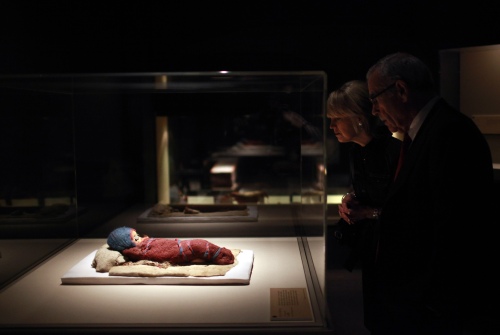PHILADELPHIA (AP) ― A museum said Friday that its exhibit on the Silk Road, including a pair of ancient mummies, will go on after it resolved a dispute with the Chinese government that led to a pared-down event with fake mummies and life-sized photos of the artifacts.
The exhibit will reopen Feb. 18 with a full complement of mummies and more ancient artifacts from the Tarim Basin in the autonomous Xinjiang Uyghur region of China, the University of Pennsylvania Museum of Archaeology and Anthropology said.
The artifacts are part of “Secrets of the Silk Road,” which opened last Saturday. The exhibit had traveled to museums in California and Texas without issue but the Philadelphia museum was asked to gut its display.
Museum spokeswoman Pam Kosty did not say what sparked China’s change of heart but said the initial delay was the result of a miscommunication.
“We had extraordinary help from the Chinese Embassy and Chinese officials to make this happen,” she said.
The exhibit will reopen Feb. 18 with a full complement of mummies and more ancient artifacts from the Tarim Basin in the autonomous Xinjiang Uyghur region of China, the University of Pennsylvania Museum of Archaeology and Anthropology said.
The artifacts are part of “Secrets of the Silk Road,” which opened last Saturday. The exhibit had traveled to museums in California and Texas without issue but the Philadelphia museum was asked to gut its display.
Museum spokeswoman Pam Kosty did not say what sparked China’s change of heart but said the initial delay was the result of a miscommunication.
“We had extraordinary help from the Chinese Embassy and Chinese officials to make this happen,” she said.

The current exhibit will close Sunday so many of the original displays can be installed. It will reopen Feb. 18 and run through March 15. The exhibit will continue March 17-28 without the mummies.
“We are delighted to be able to present the complete range of this spectacular material,” said Richard Hodges, the Williams Director of the Penn Museum.
The exhibit’s main attraction is a nearly 4,000-year-old, pristinely preserved mummy from far western China, whose flaxen hair and eyelashes are still intact. A well-preserved mummy of a baby, along with vibrantly colored burial trappings of a third mummy, will be among more than 100 ancient objects featured, including pottery, masks, jewelry and coins.
The mummies are particularly fascinating because they have Caucasian features, proving that populations migrated eastward from Europe and brought their customs and skills with them.
Other artifacts include clothing, fabrics, wooden and bone implements, and even preserved foods such as a wonton, spring roll and fried dough.



![[AtoZ into Korean mind] Humor in Korea: Navigating the line between what's funny and not](http://res.heraldm.com/phpwas/restmb_idxmake.php?idx=644&simg=/content/image/2024/04/22/20240422050642_0.jpg&u=)
![[Exclusive] Korean military set to ban iPhones over 'security' concerns](http://res.heraldm.com/phpwas/restmb_idxmake.php?idx=644&simg=/content/image/2024/04/23/20240423050599_0.jpg&u=20240423183955)



![[Graphic News] 77% of young Koreans still financially dependent](http://res.heraldm.com/phpwas/restmb_idxmake.php?idx=644&simg=/content/image/2024/04/22/20240422050762_0.gif&u=)
![[Herald Interview] Why Toss invited hackers to penetrate its system](http://res.heraldm.com/phpwas/restmb_idxmake.php?idx=644&simg=/content/image/2024/04/22/20240422050569_0.jpg&u=20240422150649)





![[Exclusive] Korean military to ban iPhones over security issues](http://res.heraldm.com/phpwas/restmb_idxmake.php?idx=652&simg=/content/image/2024/04/23/20240423050599_0.jpg&u=20240423183955)



![[Today’s K-pop] Ateez confirms US tour details](http://res.heraldm.com/phpwas/restmb_idxmake.php?idx=642&simg=/content/image/2024/04/23/20240423050700_0.jpg&u=)